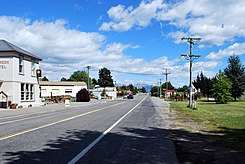Duntroon (New Zealand)
| Duntroon | ||
| Geographical location | ||
|
|
||
| Coordinates | 44 ° 51 ′ S , 170 ° 41 ′ E | |
| Region ISO | NZ-CAN | |
| Country |
|
|
| region | Canterbury | |
| District | Waitaki District | |
| Ward | Corriedale Ward | |
| Local foundation | 1849 | |
| Residents | 87 (2013) | |
| height | 140 m | |
| Post Code | 9494 | |
| Telephone code | +64 (0) 3 | |
| Photography of the place | ||
 Main street of the place |
||
Duntroon is a small village in the Waitaki District of the Otago regionon the South Island of New Zealand .
Origin of name
Derived from the Scottish Gaelic Dùn Treòin , the place got its name from the Scottish farmer Robert Campbell when it was founded in 1849 . The Scottish town of Duntroon was the patron.
geography
The village is around 35 km northwest of Oamaru and just under one kilometer within sight of the Waitaki River flowing northeast . The Maerewhenua River flows directly south to west past the place, which flows into the Waitaki River shortly afterwards . Coming from the northwest, New Zealand State Highway 83 runs directly through the village and connects to the east with the communities of the east coast. About 6 km to the southwest are the " Earthquakes ", a formation of limestone cliffs.
history
Duntroon used to be the terminus of a branch line later known as the Kurow Branch . The place was one of the few that had the entire operating time of the line via a station (the other stations already closed before the line was closed). In 1875 the line was opened as a branch from the South Island Main Trunk Railway at Pukeuri . Because of problems with the bridge construction, the track ended outside of Duntroon on the east bank of the Maerewhenua River . Three years later the construction of a line from Duntroon to Kurow began . On July 2, 1881, the bridge over the Maerewhenua River was completed and Duntroon was connected to the New Zealand rail network. On November 7, 1881, the line was opened beyond Duntroon . The line was closed in mid-1983 and the station is used by the community. A water tank for supplying the steam locomotives has been preserved near the station building.
population
For the 2013 census, the village had 87 inhabitants, which means a decrease in the number of inhabitants of 23.7% compared to the 2006 census.
economy
The economy is characterized by agriculture, especially sheep breeding and the cultivation of wheat and barley.
Attractions
In Duntroon is the " Vanished World Heritage Center ", in which the geology of the Waitaki region is shown and fossils from the region are exhibited. These include whales and two penguin species of the genus Archaeospheniscus , Lowe's penguin and Lopdell's penguin , which were found in the local formation from “ Kokoamu Greensand ”.
A forge, which is more than 100 years old, is still partly in operation.
In the vicinity of the place there are several centuries-old Māori rock carvings . The Takiroa Rock Drawings are located 2.5 km west of the village, the Maerewhenua Drawings 2 km southeast, the Earthquake Shelter 6 km west.
In the valley of the Maerewhenua River 5 km south of Duntroon there is a rock formation, the Elephant Rocks , where scenes from the first film in the Chronicles of Narnia were filmed in 2005.
leisure
In the Waitaki River salmon and trout can fished and watercraft to be driven.
literature
- Helga Neubauer: Duntroon . In: The New Zealand Book . 1st edition. NZ Visitor Publications , Nelson 2003, ISBN 1-877339-00-8 , pp. 781 .
Web links
Individual evidence
- ↑ a b 2013 Census QuickStats about a place: Duntroon . Statistics New Zealand , accessed June 3, 2017 .
- ↑ a b c d Neubauer: Duntroon . In: The New Zealand Book . 2003, p. 781 .
- ↑ Topo250 maps . Land Information New Zealand , accessed June 3, 2017 .
- ^ Jock Phillips : Filming at Elephant Rocks . In: Te Ara - the Encyclopedia of New Zealand . Ministry for Culture & Heritage , September 24, 2007, accessed October 9, 2017 .






